When it comes to stunning houseplants, we often focus so much on styling indoor rooms and balconies, that we forget about the front door. Showing your front door some landscaping love with the perfect plants not only makes your home look more inviting, it also helps reflect your design style. Choosing the perfect plants to frame your doorway will bring extra life to your home before visitors even step inside. From traditional trailing ivy, to modern framing with cacti, you can create the perfect entranceway to your home. Today we are going to list our top 10 favourite front door plants.
How to Create a Beautiful Entranceway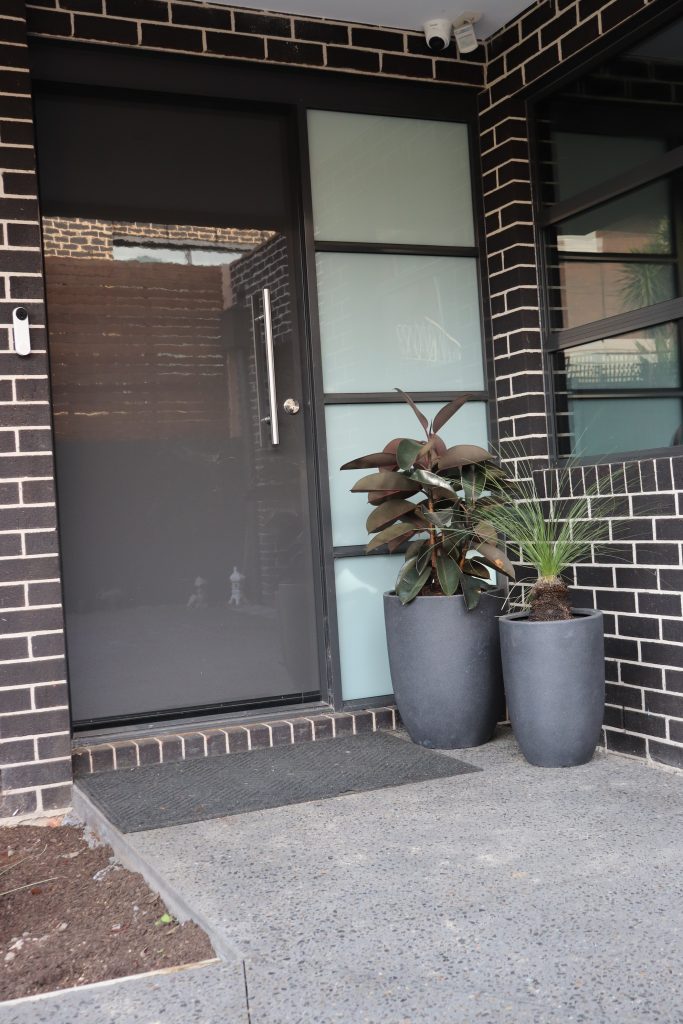
It is actually quite easy to create a striking combination of front door plants. We recommend a good, 20-inch pot that is big enough to be seen from the street and, of course, a good soil. Then use the rule of three. Three plant heights, three plant textures, and three plant colours. This way, your front door planter will always look good. These rules below will help you create the perfect front door planter design:
1: This is not a Centerpiece
It is important not to design your planters the way you would design a centrepiece. If you want your plants to be admired from a distance, then the tallest plant should go toward the back. This then gives you room to plant the fluffier, showier plants toward the front and the sides.
2: Good Quality Soil
As with all plants, soil quality matters a lot. To ensure your plants stay happy and healthy you need to choose a high quality, well-draining soil. If you’re unsure what to choose, you can always ask your local nursery, like Aumanns, for advice.
3: Planter and Pot Size
Choosing the right sizes pot or planter is important. You need to ensure there is enough space for all the plants without overcrowding. But at the same time, you shouldn’t have a container that is too big. Once again, if you are using one planter or pot for multiple plants, it is best to ask your local nursery, like Aumanns, the best size for your chosen plants.
4: Fertiliser
Most plants need a good fertiliser. Especially if they are producing flowers or fruit throughout the season. So you will need to give them a bit of them a boost every few weeks during spring and autumn to ensure your plants stay healthy.
Our Favourite Front Door Plants
There are a number of wonderful plants to use to welcome people into your home. From plants with soft, round edges, to those with sharp, straight modern ones, there are myriad choices. It is important to do some research and make sure you choose something that will not only do well at this part of your home, but will also thrive in the light and temperature elements there. Below are our top 10 favourite beautiful front door plants!
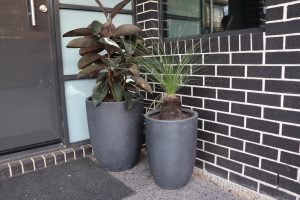
1: Grass Tree
This native Australian plant is a stunning, slow-growing plant easily identifiable by its iconic foliage. The grass tree’s stunning foliage forms a skirt around the centre of the plant and sometimes even flowers. It is a tough plant that will grow in coastal areas as well as most dry and wet forests. Traditionally, the grass tree needs fire to promote flowering and growth, however you can still get amazing results from your grass tree without potentially lighting your entire garden on fire!
Grass trees grow happily in a wide variety of soils, from deep sand to heavy gravel-filled soil. So it is an easy plant to mix into planters. It is a tree that needs either full sunlight or broken sun, however, not shade so make sure you pair it with other plants that like full sun.
You can grow a grass tree from seed or from a seedling, or small plant, from a garden centre like Aummans. However, if you want to grow from seed you will be in for a wait. Grass trees grow at a rate of 2cms a year, taking nearly 20 years to grow a trunk and even more to reach full size.
Grass tree roots depend on specific microbes in the soil. So when it comes time to transplant your grass tree, you will need to bring as much of the original root soil with the plant as possible. With will give the plant the best chance of growing healthily in its new pot or location.
Grass trees produce a flower spike that is around 2m high. They tend to grow after the plant experiences stress which, traditionally, was after a bushfire. In garden spaces, however, most grass tree owners stimulate the flower growth by placing a small stone on top of the growing tip. This causes enough stress that the flower will form. It is important to remove the flower stalks after the season to reduce unneeded stress on the plant, allowing it to continue focusing on establishing a healthy root system.
Grass trees need regular watering in their first 2 years of planting. But be careful not to over water your plants. Once established, there’s no need to prune your grass trees, other than for aesthetic reasons or, if there is a bushfire risk in the area, to remove dry foliage.
With plenty of time, care and love, grass trees can reach up to 6m high with a visible trunk.
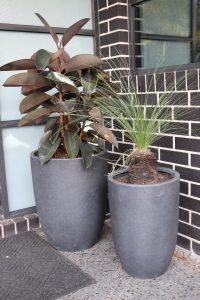
2: Rubber Tree
Also known as a Ficus elastica, the rubber tree can grow up to 15m tall, making it an incredibly dramatic plant to grow around your front door. Rubber trees are also one of the easiest plants to care for, especially when starting from a young rubber tree plant. When it comes to growing a healthy rubber tree, the proper light and water is essential. A rubber tree needs bright light, but prefers to have indirect light that isn’t too hot. So you don’t want to use rubber trees if the front of your home gets a lot of sun.
Rubber trees also need the right amount of water. During their growing season they should be kept moist and we recommend watering at least once a week. You should also check to see if the leaves need dirt or dust wiped off them, especially in summer, to ensure they are still properly absorbing sunlight. Wiping your rubber tree down can be done with a damp cloth or spritzing them with a light hose.
Your rubber tree will signal you if you are watering it too much by its leaves turning yellow and brown and falling off. To promote new leaves on a rubber tree, you can cut a slit in the node where a leaf fell off as this will allow a new leaf to grow quicker.
During the dormant season, rubber trees should only need to be watered once or twice a month. If the leaves begin to droop but not fall off, increase the water you give them until the leaves perk up again.

3: Areca Palm
If you have space for larger plants, why not consider the areca palm? An areca palm can bring a lot of life and energy to your space. It is also the perfect plant to bring life to stagnant corners of your home. But it is also the perfect plant if you want something dramatic for your front door and entranceway.
With the added benefit of filtering and purifying the air, areca palms have feathery, arching fronds. Each frond holds up to 100 leaflets, ensuring these big, bold palms command attention. However, buying a fully grown areca palm is expensive, so we recommend buying them at a younger, smaller size and allowing them to grow. Areca grow 6-10 inches a year until they reach a mature height of around 6-7 feet.
Areca palms are one of the few palms that can tolerate trimming without serious harm to the plant. A key factor to successfully growing a healthy areca is not only trimming but also light and water. Areca palms need bright, indirect light as their leaves turn yellow-green in direct sunlight. These plants won’t tolerate much neglect. They need to be watered often to keep the soil lightly moist in spring and summer. In autumn and winter, allow the soil to dry slightly between waterings.
Areca palms prefer a time-release fertiliser in the spring. This will give the plant most of the nutrients it needs for the entire spring season. Its fronds also benefit from a micronutrient spray in summer – you can use a liquid houseplant fertiliser containing micronutrients for this. Make sure the fertiliser is safe for foliar feeding and dilute it properly. Do not feed areca palms in autumn and winter.
Areca palms need repotting every 2-3 years. They prefer a tight container and crowding the roots helps limit the size of the plant. The main reason for repotting is to replace aged potting soil and to remove any fertiliser salt deposits that might have built up in the soil and sides of the pot. Use palm potting soil or a general purpose soil mixed with a handful of builder’s sand. Take care to plant the palm in the new pot at the same depth as the old pot. Planting too deep can cause serious injury to the palm. Don’t try to spread the roots out as they are incredibly brittle. Once you’ve filled soil in around the roots, press down with your hands to make sure the soil is packed tightly and you’ve eliminated air pockets.
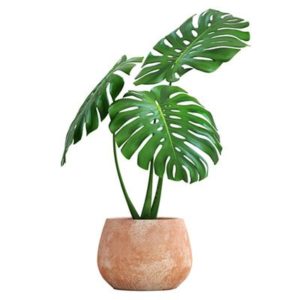
4: Monstera or Swiss Cheese Plant
Monstera are one of the most recognisable and beloved indoor and outdoor plants. They are prized for their beautiful, heart-shaped leaves and how quickly they grow under the right conditions. They are commonly known as the Swiss Cheese plant due to the distinctive holes in their leaves. Monstera are vining plants, so you will need to provide it with a support of some kind to climb upwards. A moss pole, like those found at garden centres, are ideal and provide a place for the aerial roots to take hold.
Start with a good, well-draining potting mix. Ensure it is one that has necessary nutrients but is formulated without compost or pine bark as these types of soil can harbour pests.
Monstera come from tropical climates and thrive in lower levels of the tropical rainforest floor. So the more you can replicate the conditions, the better your monstera will grow. This makes the monstera a perfect choice for space with bright, indirect light that is protected from the wind and harsh direct sunlight.
Monstera can grow up to 20m tall, with big, dramatic leaves, making it a spectacular choice for a front door plant. and front door spaces are usually bigger and roomier, giving it space to flourish like it would in the wild.
Water your monstera when they are putting on growth, and when the soil begins to dry out. You can check when the soil is dry by gently pushing your finger into the soil to test for moisture. These plants also love high humidity, so tropical climates are ideal for growing monstera plants.
A premium potting mix containing fertiliser is perfect for feeding your plants the first couple months after potting. It is important to continue replenishing nutrients once the fertiliser in the soil runs out so the plant stays happy and healthy. These plants grow fast and they benefit from being repotted from time to time, to prevent them getting rootbound and out growing their pots. Report them into a larger pot to allow for growth or repot tired looking plants with fresh soil to maintain their overall health. Over time, the monstera will grow aerial roots. You should encourage them to attach to either the moss stick or gently push them into the potting mix.
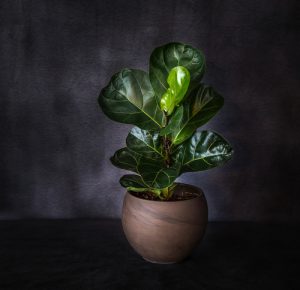
5: Fiddle Leaf Fig
One of the most popular plants right now, fiddle leaf figs are truly stunning plants. Their upright trunks and large, impressive leaves. They are the perfect addition to your front door as they can also incredibly tall, making them a bold statement piece for your entryway. They are not the easiest plants to grow but they are very rewarding to grow.
Fiddle leaf figs have very large, heavily veined, and glossy leaves. They are a stunning focal point, growing to nearly 6 feet tall. These plants are fast growing and can be potted at any time of the year.
These gorgeous plants are native to tropical areas of Africa, so they will prefer tropical environments more. You may have more luck growing them outdoors in Queensland than in Melbourne, for example. Keep this plant in warm, wet conditions is challenging as the fiddle leaf fig comes from a tropical environment.
These plants are not especially demanding as long as you can get their environmental conditions right. It is also important to wipe the leaves off frequently with a damp cloth to keep the leaves shiny and appealing, but to also ensure the maximum amount light hit the leaves. We also recommend trimming off dead and damaged leaves as they arise, as they no longer benefit the fiddle leaf fig. You can also prune off the top of the main stem if you want your front door plants to be bushier rather than tall.
Fiddle leaf figs prefer bright, filtered light to look their best. If your front door gets mostly direct light, then a fiddle leaf is not the best for you. Direct sunlight can burn the leaves, especially the hotter afternoon sun. conversely, fiddle leaf figs kept in low light conditions will fail to grow rapidly, so ensure your space has good, filtered light before choosing the fiddle leaf.
A good quality soil that drains well is all a fiddle leaf fig needs. They prefer a moderate amount of moisture in the soil. If the fig doesn’t get enough water, the leaves will wilt and lose their bright green colour. But if the fiddle leaf fig gets too much water, the plant might drop its leaves and even suffer from root rot, which can ultimately kill a plant. Water you plant whenever the top inch of the soil feels dry during summer and spring and slightly less over autumn and winter.
You need to fertilise throughout the spring and summer with a high-nitrogen plant food. The best option is if you can find one specifically for fiddle leaf figs. However, fiddle leaf figs are highly sensitive to high salt levels in soil which can be caused by fertiliser. So it is important that you flush the soil out with water (keep watering the pot until water comes out the bottom) at least once a month. This will help prevent salt build up.
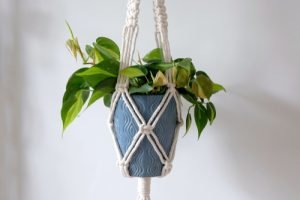
6: Pothos
For beginner gardeners, pothos are a great option. They are very forgiving, with beautiful, trailing stems that make them a great candidate to cascade down from hanging planters to be grown up pillars, deck posts, and more.
Caring for pothos is easy, making this plant a lovely addition to your front door and entryway. These plants enjoy a wide range of environments. They enjoy bright, indirect light as well as low light and thrive in nutrient rich soil as well as poor soil. They can even survive for a while in very dry soil.
You should fertilise a pothos plant about once every three months as this will help your front door plants grow faster.
It is important to remember, however, that pothos plants are poisonous. While poisoning is rarely fatal, they cause irritation and vomiting when eaten. Even the sap can cause people sensitive to them to break out in a rash. If you have small children or pets who will have easy access to the front of your home, then the pothos might not be the plant for you.
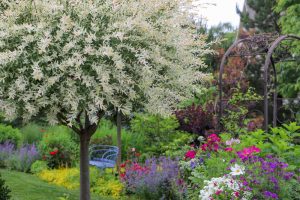
7: Willow
Willow trees are gorgeous and always dramatic, making them the perfect choice for your front door. They are ideal for almost any climate and love full sun. Their stems and limbs aren’t strong though so they may bend and break in strong storms, so make sure they are properly sheltered. Willows come in a wide variety of fast growing, easy-to-care for species to suit your front door needs and they can be grown in large pots.
Weeping Willows
Weeping willows have graceful, arching stems that delicately dangle toward the ground. The stems and leave shier in the breeze, making for a stunning and serene front door design. And they can be grown in pots for a beautiful, ornamental look.
Gold/White Willows
A European species of willow, they are often used as screens in gardens or even shelterbelts. And, like the weeping willow, they can be happily grown in pots to grace your front door space.
Black Willows
Native to North America, black willows are common along waterways. They look absolutely stunning in an ornamental pot in entranceways or as part of your garden.
Corkscrew Willows
When it comes to the perfect ornamental tree for your front door, look no further than the corkscrew will. These trees have highly decorative stems that spiral appealingly. This means they still look eye catching in winter when they lose their leaves and expose their spiralling trunk. These living sculptures love growing in pots, making them ideal front door plants.
Willows are easy to grow and require only moderate care. You should prune young trees to keep lower limbs up. This makes for easier maintenance in the future. Otherwise, your willow won’t need pruning aside from removing old, dead wood when required.
Willows prefer moist, organic-rich soils. If your soil quality is poor or you can only get an all-purpose potting mix, work a good mixture of compost in when you pot your willow. Then, in early spring, fertilise with a good, all-purpose plant food.
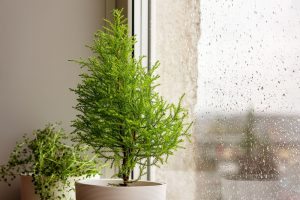
8: Cypress
Cypress are fantastic, upright conifers with fragrant, blue green foliage. Its shape is perfect to frame a doorway, adding height and drama. This evergreen foliage is a hardy plant that can grow up to 12m tall. It likes full sun and moist but well-drained soil.
Cypress are native to North America and fast growing, making them ideal as front door plants. When planting, choose a good, rich, acidic soil. After potting, drench the soil and then cover the root zone with organic mulch.
Give the cypress tree a good soaking every week for the first few months to ensure it establishes itself in its pot. Cypress trees also need water the most in spring when they get their growth spurts and then in autumn before they go dormant in winter. Cypress trees can withstand drought once it is established but its best to water your tree if you haven’t had a good, drenching rain in more than a month or your tree is under shelter where it cannot get water from rainfall.
Wait at least a year after planting your tree before fertilising for the first time. Fertilise the tree every year or so with a balanced fertiliser.

9: Cacti
Cacti create a striking, minimalist look to your front door or entranceway. They suit an array of modern homes and those with little space for larger, bushier plants. They come in a wide range of styles, sizes, and shapes to suit your home, though we do love the look of a pair of tall cacti framing an entryway!
While we associate cacti with deserts, they actually grow in a wide variety of climates. You can find cacti as far north as Canada and some are even native to rainforest regions around the world. Desert dwelling cacti can survive for long periods without rain or watering, making them ideal for beginner gardeners and ideal for display.
Cacti are undemanding and withstand most maltreatment, other than overindulgence – like overwatering. Overwatering will cause your cactus to turn mushy and start to rot. Cacti need bright light and fresh air to grow well. You can either plant a large cactus alone or group a collection of cacti together in a range of different sizes to create a unique look. Ensure you plant your cacti in well-draining pots and in a soil mix specifically made for cacti and succulents. Most garden centres, like Aumanns, will have soil specifically designed for cacti and succulents.
Water cacti well in spring and summer but let them dry out completely between waterings in winter, especially in colder climates. During summer and spring, fertilise your cacti with a well-diluted tomato fertiliser every three weeks.
You should only repot your cacti when the roots completely fill the pot. Otherwise, they are happy to be left alone.
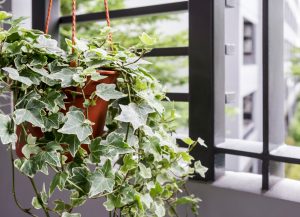
10: English Ivy
English ivy is one of the classic framing front door plants. When we think of old English cottages, we imagine homes draped and framed by thick layers of ivy. English ivy is a superb climber, able to cling to almost any surface thanks to the small roots along the stems. And their care is super easy, meaning you don’t have to worry about much maintenance.
Ivy prefers a shady area and a pot with organically rich soil. The vines can grow 15m long and more but don’t expect a lot of growth at first. The first year after planting, English ivy will grow very slowly. By the second year, however, you will see more noticeable growth and by the third year they will quickly cover trellises, poles, pillars, columns, walls, fences, etc. You can also use shaped wire to grow the ivy around, to create a clever topiary design.
You will need to water English ivy enough to keep the soil moist. This should be done until the plants are established and growing as the vines grow best when they have plenty of moisture. However, once your ivy establishes itself, it can tolerate some dry conditions.
Ivy doesn’t need fertiliser but if you don’t think a plant is growing as well as it should, you can spray down an ivy plant with a half-strength liquid fertiliser.
Looking to make a great impression by framing your front door with wonderful front door plants? Come into one of Aumanns garden centre’s today! We have a wide range of perfect plants to suit your needs and the front door design you have in mind!

